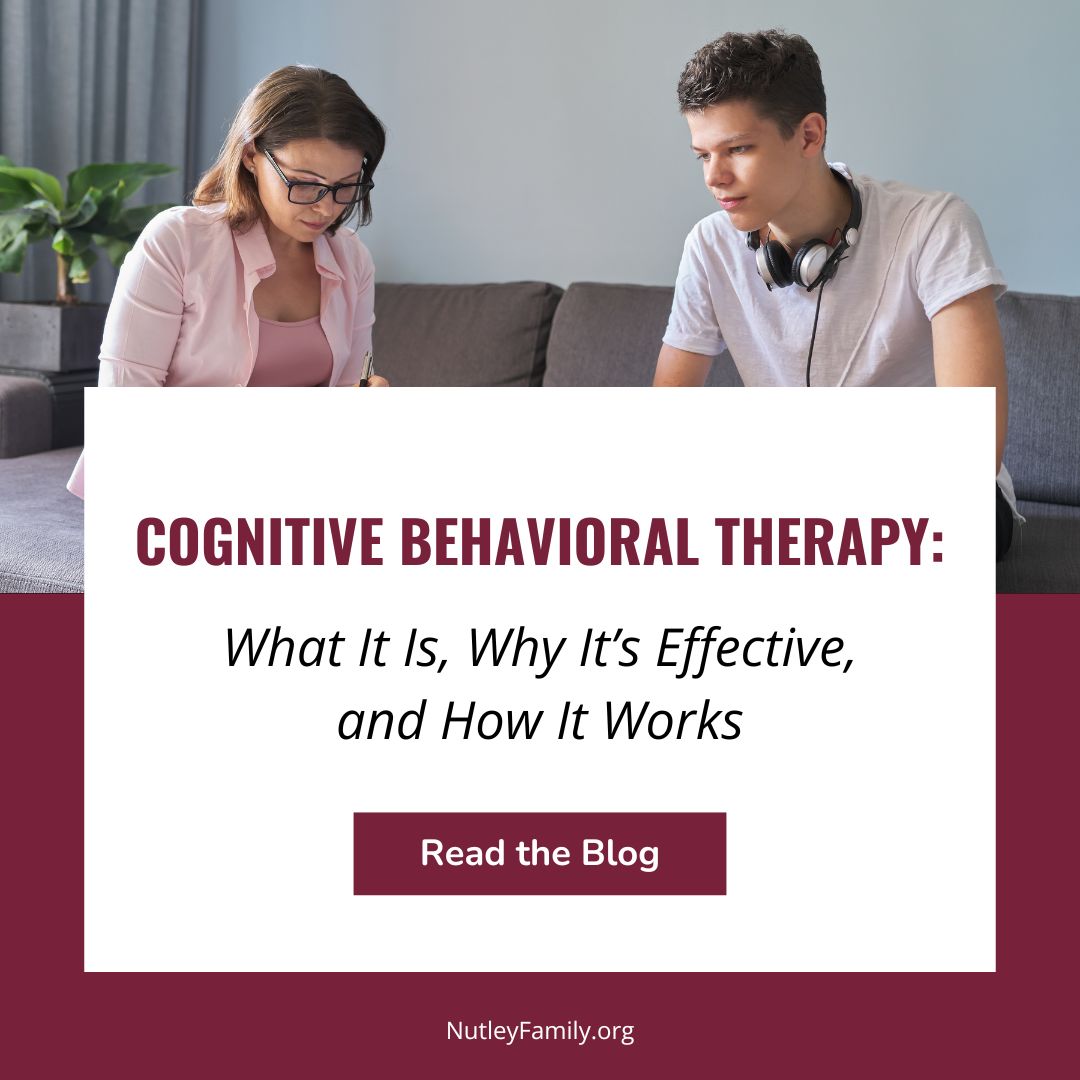-
Cognitive Behavioral Therapy: What It Is, Why It’s Effective, and How It Works
- Posted on May 13, 2024
- by admin
- in All Articles, Mental Health, NFSB Blog
- Comments Off on Cognitive Behavioral Therapy: What It Is, Why It’s Effective, and How It Works

Did you know every mental health clinician at Nutley Family Service Bureau (NFSB) is trained in cognitive behavioral therapy (CBT)? CBT is the most common form of psychotherapy, or talk therapy, used by social workers, psychologists, and other counselors to treat mental health disorders.
CBT is also among the most researched forms of therapy and has produced positive, evidence-based results in the treatment of a variety of conditions. Let’s discuss the definition of CBT, how it works, and why CTB is such a valuable tool for both counselor and client.
What Is CBT?
In the simplest of terms, CBT helps people identify and change unhelpful patterns of thought and behavior that are not serving them.
“If we break it down into pieces, the cognitive part focuses on thoughts that automatically surface and influence how you feel or behave,” said Kelly Rivadeneyra, LCSW, Assistant Director of the Mental Health Center at NFSB. “These thoughts could be distorted or completely inaccurate. The idea is that the way you think about things affects the way you feel about things, and both might affect your behavior.”
Behavior is the second piece. CBT helps you recognize certain patterns of behavior that might be contributing to your struggles. Once you gain awareness and understanding of these behaviors, you can learn to develop healthier, more productive ways of responding to stressors.
Conditions commonly treated with CBT include but are not limited to:
- Anxiety disorders
- Depression
- Bipolar disorder
- Eating disorders
- Phobias
- Post-traumatic stress disorder (PTSD)
- Anger management
- Sleep problems
- Low self esteem
Progress Through Active Involvement in Treatment
Perhaps the biggest reason CBT has proven to be effective is that it empowers you to take an active role in your own healing process.
“You’re not just talking,” Kelly said. “This is a skills-based approach focused on learning actual tools, techniques, and skills that you can apply in your life when you’re dealing with difficult emotions. And CBT is very collaborative between you and your therapist. The therapist is simply a guide.”
Bringing the relationships between thoughts, feelings, and behaviors to light helps you gain a sense of control. You learn to make a distinction between what your negative thoughts are, where they originated, and whether they are valid. Thoughts are often shaped by past experiences, and CBT helps bring you back to and focus on the present.
The CBT Process
CBT is frequently used when someone is struggling with some form of anxiety. They feel increasingly anxious and seek therapy when their anxiety is reaching a point at which it’s affecting their ability to enjoy life in the moment. Let’s take a look at a scenario involving social anxiety. You believe people are judging you. You’re afraid you’ll feel embarrassed and people won’t like you.
“The first step is to work with the therapist to identify thoughts that are popping up in these specific moments where your anxiety is heightened,” Kelly said. “We go through a triangle process of discussing how thoughts and feelings are affecting behavior. The behavioral outcome could be that you just avoid these things altogether.”
The second step is to start challenging these negative thoughts and beliefs. This could involve exploring evidence for or against these thoughts, almost like putting them on trial. You may find that there is an alternative explanation as to why someone might be acting a certain way that you could be misinterpreting.
The next step involves behavioral experiments. The therapist encourages or recommends testing beliefs about what you think will happen.
“In this scenario, you gradually expose yourself to social situations, paying close attention to people who are actually responding to you,” Kelly said. “This helps you gather evidence to challenge your negative beliefs. A big part of CBT is practicing coping skills for managing your anxiety, like deep breathing and mindfulness exercises.”
Coping skills prevent you from becoming dysregulated while you’re practicing them. The goal is to start noticing these changes in your thoughts and behaviors. With ongoing practice and therapy, you can avoid returning to a place where you were experiencing a lot of stress.
How Long Does It Take to See Results?
Obviously, the amount of therapy required depends on the individual. That said, CBT is not considered a long-term therapy. In fact, CBT is often shorter than many other treatment techniques.
CBT can produce meaningful results in 10-20 sessions. With consistent counseling and practicing of coping skills, sessions become less frequent. At that point, appointments are considered maintenance check-ins to reinforce positive coping skills.Keep in mind that CBT is not for everyone. CBT may not be the best choice for people struggling with complex or severe mental health challenges or learning disabilities. However, clinicians at NFSB have seen a tremendous amount of success using CBT to treat a wide range of conditions.
“CBT is such a great tool to keep with you long after therapy,” Kelly said. “Once you learn it, you can apply it whenever you need it. CBT gives you something tangible that you can practice for the rest of your life.”
If you enjoyed this article please consider sharing it!

















